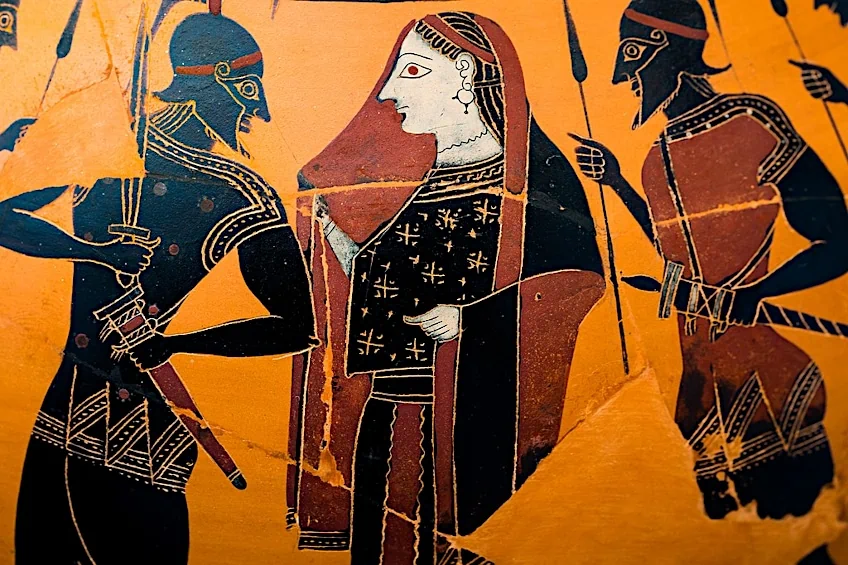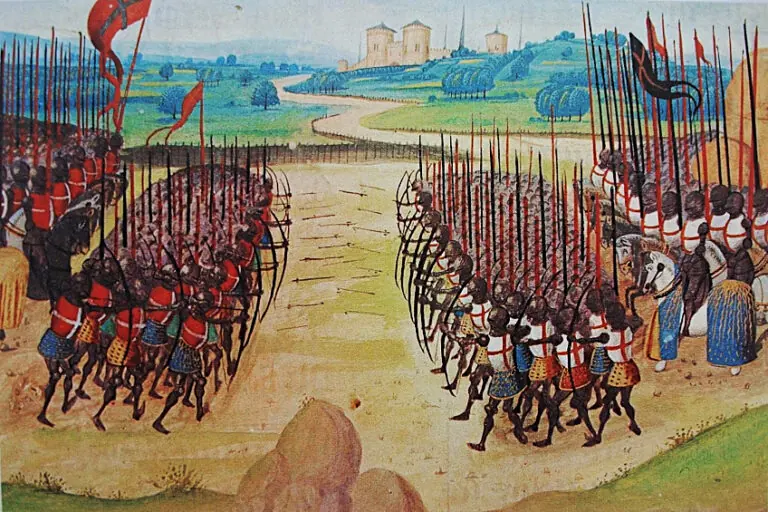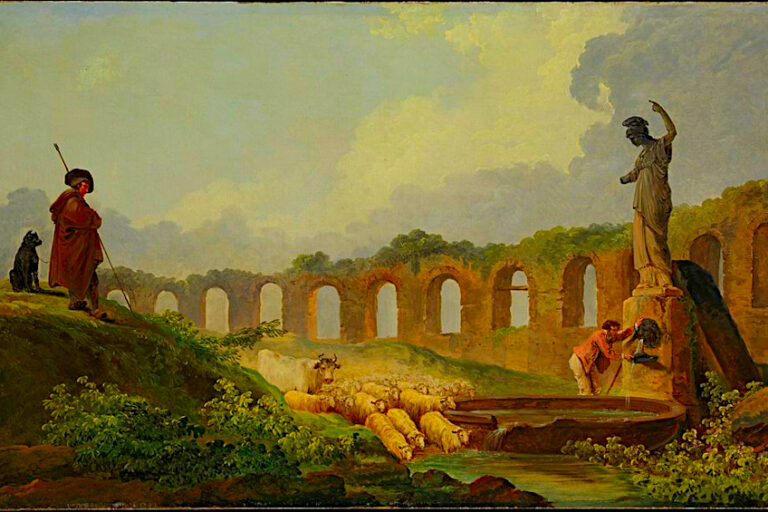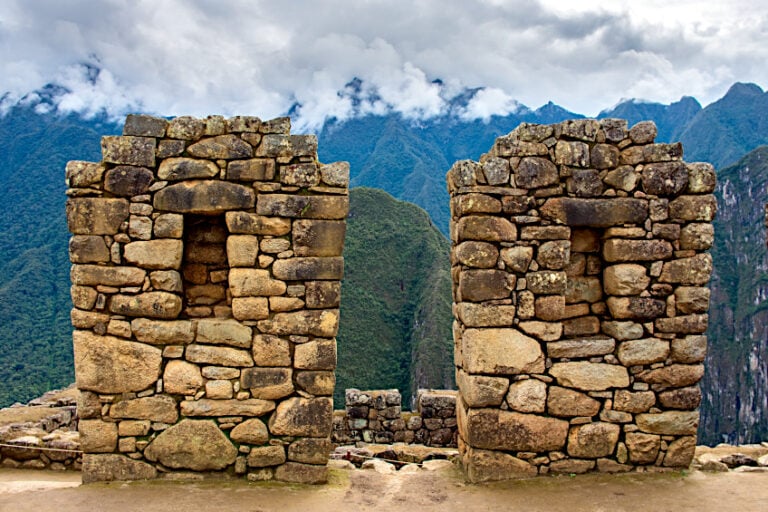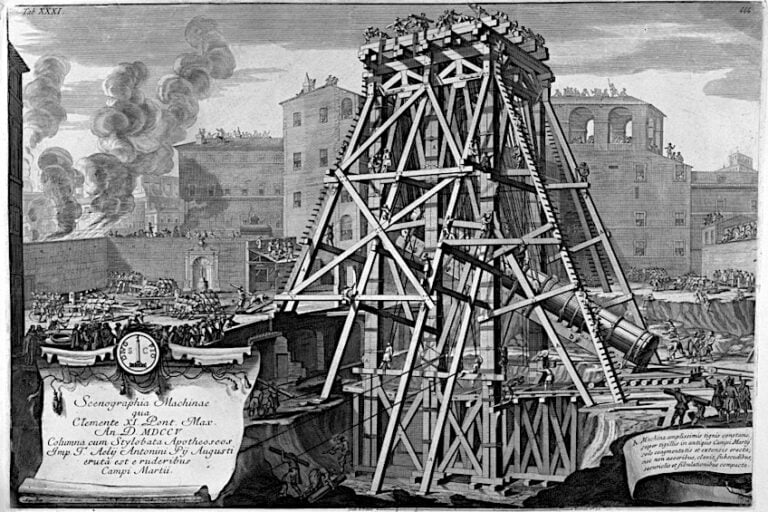Archaic Greek Art – Art from an Age of Epic Change
The Archaic Greek period in art history reflects some of the earliest patterns and trends in the culture and art of ancient Greece. The development of Archaic Greek art was marked by the transition from geometric shapes and rigid styles to more naturalistic representations. In this article, we will explore some interesting pieces of Archaic Greek art as well as the dominant art styles of the time.
Contents
Archaic Greece
What did Archaic Greek art look like? What are the two major types of art of the Archaic period? What were the dominant art forms of the Archaic Greek period? and what influenced Archaic Greek art? These are just a few questions that you may have regarding the art of Archaic period Greece that may seem somewhat elusive to the modern-day art student. Below, we will delve into the art of the Archaic period in Greece and some of the major influences and art styles that informed the cultural arts of the time. But first, let us look at contextualizing the era!
The Archaic period for Greece finds itself between 800 and 480 BCE, which was a significant transition between the Greek Dark Ages and the Classical period. The Archaic period saw the migration, cultural development, and establishment of trade networks across the Black Sea and the Mediterranean and was the period during which Greece saw a spike in population.
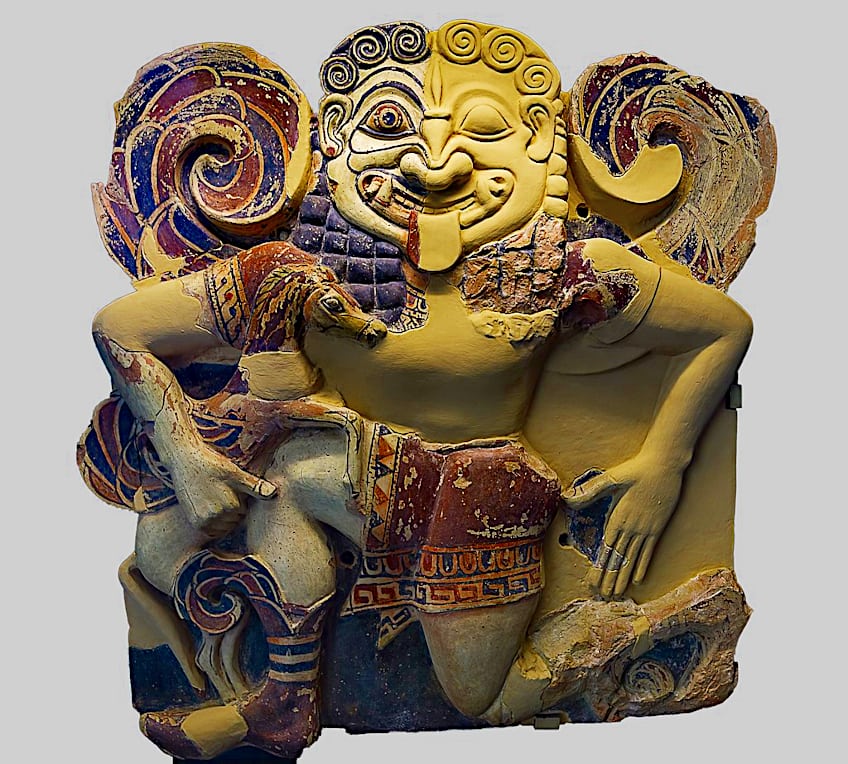 Terracotta Gorgon from Syracuse (7th Century BCE). In the Archaic period up until about 500 BCE, depictions of Gorgons known as were commonly applied to temples; Rabax63, CC BY-SA 4.0, via Wikimedia Commons
Terracotta Gorgon from Syracuse (7th Century BCE). In the Archaic period up until about 500 BCE, depictions of Gorgons known as were commonly applied to temples; Rabax63, CC BY-SA 4.0, via Wikimedia Commons
The Archaic period was defined by two revolutions; the structural revolution, which outlined the politics of the ancient Greek civilization through the establishment of city-states, and the intellectual revolution, which marked the beginning of the Classical era. Almost all defining aspects of civilization were introduced in the Archaic period and included the formation of key structures surrounding politics, culture, warfare, the development of the Greek language, and art.
 Reconstruction with polychromy of the pedestal of the Phrasikleia Kore with dedicatory inscription (between 550 and 540 BCE); R.Marthaler, CC BY-SA 4.0, via Wikimedia Commons
Reconstruction with polychromy of the pedestal of the Phrasikleia Kore with dedicatory inscription (between 550 and 540 BCE); R.Marthaler, CC BY-SA 4.0, via Wikimedia Commons
The Influence of Trade
Trade was also an important aspect of the development of art since the circulation of goods also included the circulation and networking of art and artists. Sculpture and pottery from neighboring regions, including the Nile Delta and the Levant regions, would have been in circulation, and preferences from the East were known to be incredibly influential. The end of the 8th century saw the trade network’s expansion into the Aegean region, which attracted the influence of Orientalism in Greek art for the first half of the Archaic period. Trade relations between Magna Graecia and Corinth had also reached their peak, which meant the further mixing of cultures.
The artists of the East were influential in the development of art forms such as metalwork, ivory carving, gem cutting, and jewelry making. Motifs such as griffins, animal hunting scenes, lotus designs, sphinxes, and other mythological themes were also common Eastern influences on Archaic art.
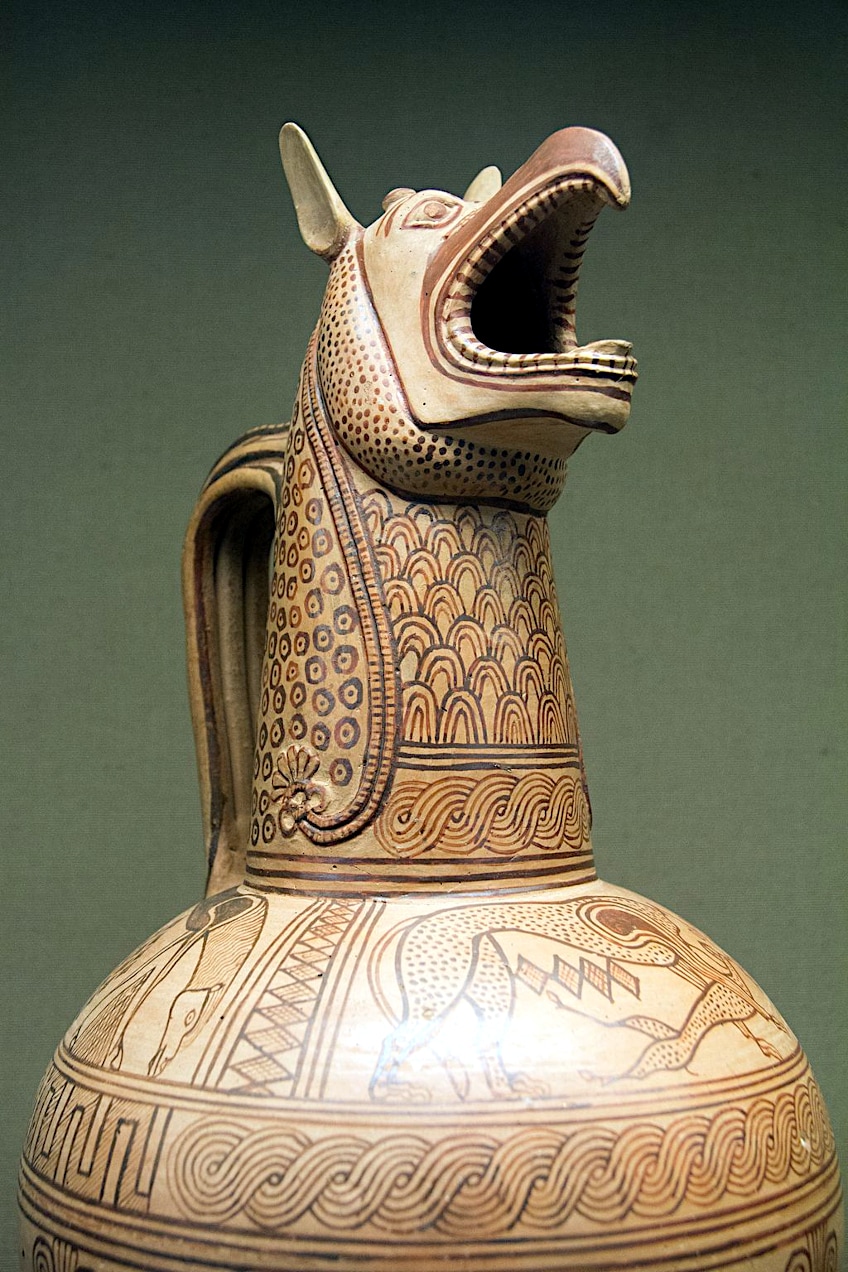 The Orientalizing phase of early Archaic Greek art saw the use of Eastern motifs such as the griffin on this jug from Aegina (675 – 650 BCE); Zde, CC BY-SA 4.0, via Wikimedia Commons
The Orientalizing phase of early Archaic Greek art saw the use of Eastern motifs such as the griffin on this jug from Aegina (675 – 650 BCE); Zde, CC BY-SA 4.0, via Wikimedia Commons
Geometry and Naturalism
The 7th century marked the beginning of the Archaic period with geometric patterns being the dominant art style between 1050 and 700 BCE. This approach soon got upstaged by the preference for naturalistic forms that are believed to be derived from art found in Egypt and the Near East.
The 6th century saw the integration of science and geometry in art, with the scientist Thales of Miletos successfully predicting the solstices and solar eclipses. The influential mathematician Pythagoras of Samos was also a pioneering figure in geometry who can be credited with shaping the thinking of the time.
Popular Archaic Period Art Forms
So, what are the two major types of art of the Archaic period? Archaic period art saw the development of two major art forms realized through sculpture and pottery; monolithic sculpture and red-figure pottery. Greek art saw the transition from rigid shapes and geometric patterns to naturalistic approaches as seen in the representation of human figures and facial expressions.
 Archaic sculptors combined color and pattern with sculpted form, as can be seen in this reconstruction of figures from the pediment of the temple of Athena at Aphaia (500 – 480 BCE); Photograph by Marsyas, CC BY-SA 2.5, via Wikimedia Commons
Archaic sculptors combined color and pattern with sculpted form, as can be seen in this reconstruction of figures from the pediment of the temple of Athena at Aphaia (500 – 480 BCE); Photograph by Marsyas, CC BY-SA 2.5, via Wikimedia Commons
Vase painting and sculpture were common art forms that birthed some of the most enigmatic “Archaic smiles” on human figures and saw an increase in artists focusing on human anatomy and bodily proportion. Architecture is also another art form that influenced the growing interest in proportion and harmony, which emerged along with the Ionic and Doric orders.
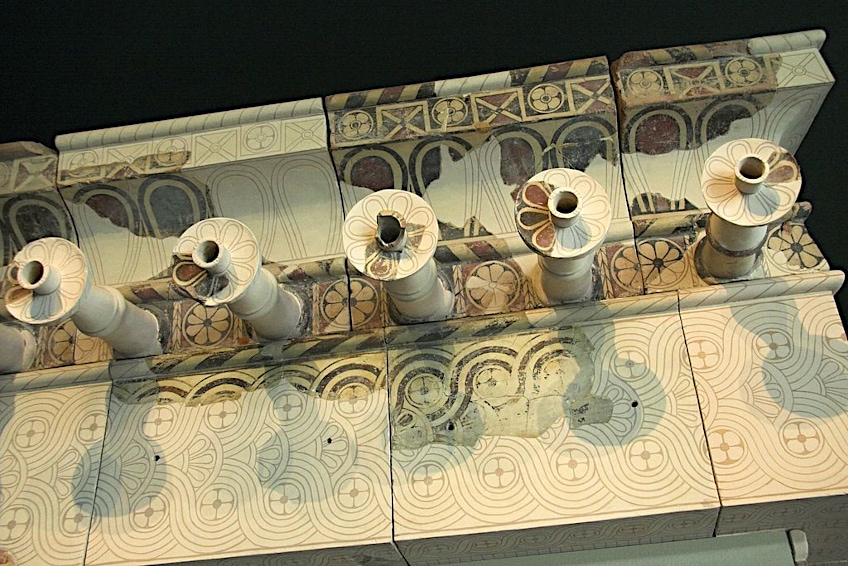 Painted terracotta was used extensively in archaic Greek temple decorations, such as these roof tiles from Via Minerva in Syracuse (610 – 600 BCE); Zde, CC BY-SA 4.0, via Wikimedia Commons
Painted terracotta was used extensively in archaic Greek temple decorations, such as these roof tiles from Via Minerva in Syracuse (610 – 600 BCE); Zde, CC BY-SA 4.0, via Wikimedia Commons
Archaic Greek Pottery
Greek pottery remains one of the best-preserved art forms from ancient Greece that demonstrate the transition from abstract expressions to figurative styles. Initially, Greek pottery largely featured geometric patterns found on Cretan pottery from the 9th century and had only been established as “popular” in the mid-8th century. The earliest examples of pottery from the Greek Archaic period were found in modern-day Syria, thus proving the mutual influence and preference for Greek pottery.
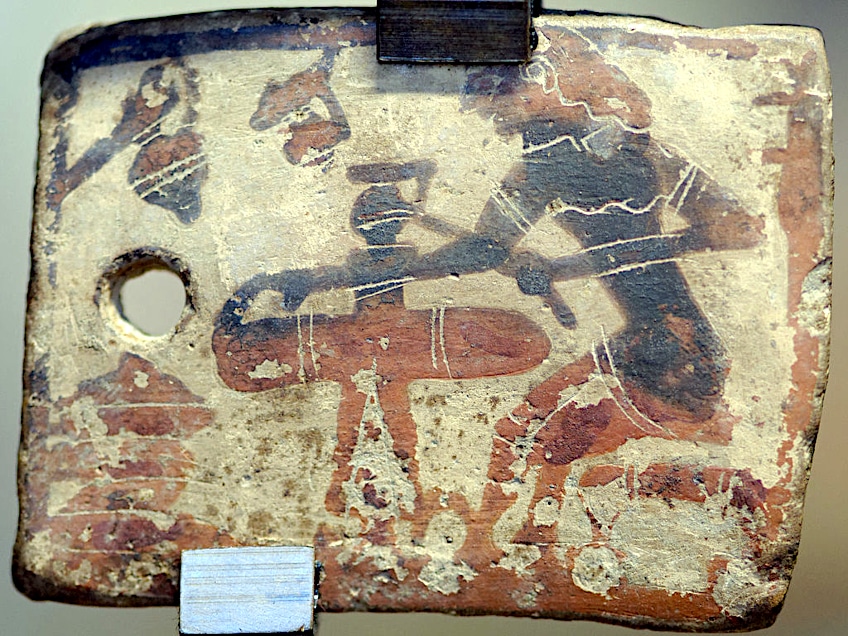 Depiction of an Archaic period potter using a pottery wheel in his workshop: Side A of a Corinthian black-figure pinax (c. 625 – 600 BCE); © Marie-Lan Nguyen / Wikimedia Commons
Depiction of an Archaic period potter using a pottery wheel in his workshop: Side A of a Corinthian black-figure pinax (c. 625 – 600 BCE); © Marie-Lan Nguyen / Wikimedia Commons
The production process of firing vessels occurred over three stages, with the first stage involving the artist letting air into the kiln to enable the oxidation of the clay. The artist would then bring green wood into the closed room and reduce the oxygen content of the room to darken the color of the vessel. The last stage entailed the reentry of oxygen back into the chamber and kiln with the glossed areas remaining black and the reserved sections remaining orange.
Archaic Greek Sculpture
The mainland of Greece comprised Athens, Sparta, and Corinth, which saw the development of ivory carving and bronze sculptures. Artists from Corinth produced their own unique style characterized by silhouetted forms of animals and plant imagery found on tapestries.
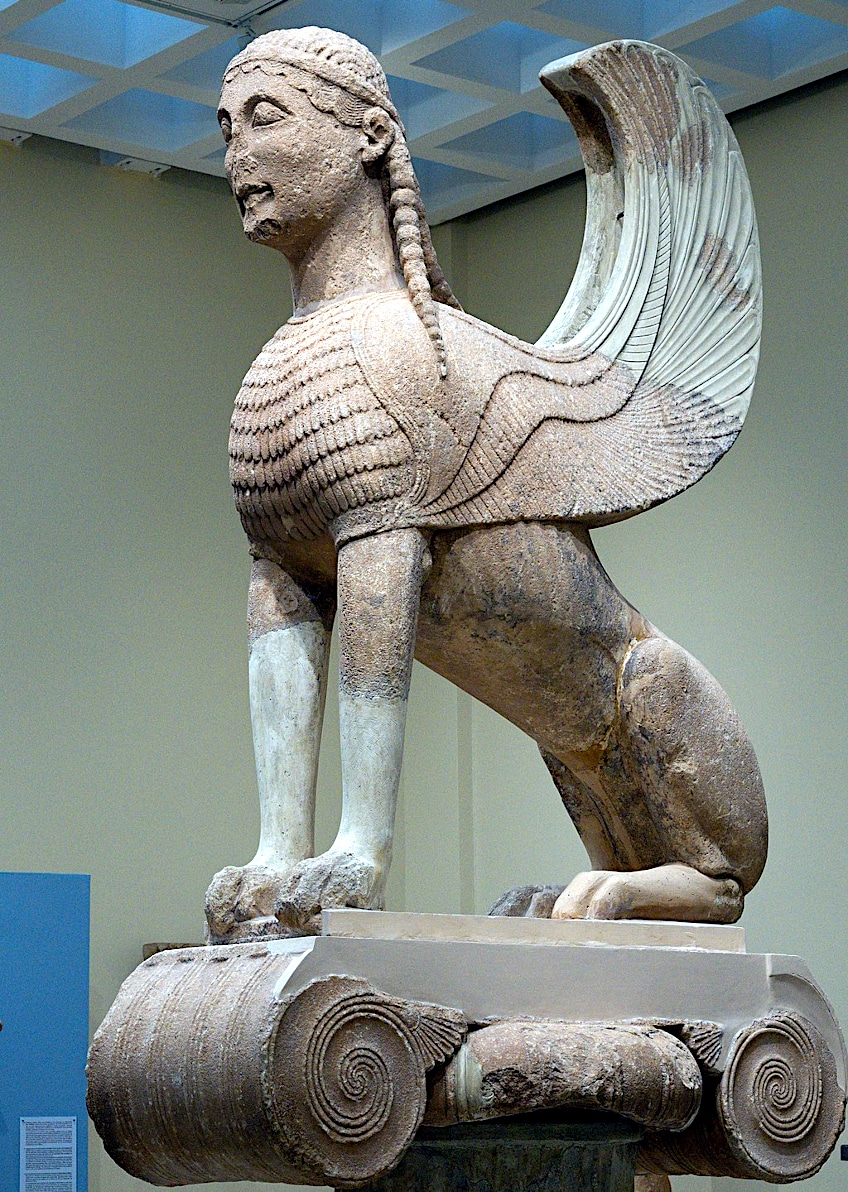 The sphinx of the Naxians sat atop a tall column and was gifted to the god Apollo to guard his sanctuary at Delphi (570 – 560 BCE); Zde, CC BY-SA 4.0, via Wikimedia Commons
The sphinx of the Naxians sat atop a tall column and was gifted to the god Apollo to guard his sanctuary at Delphi (570 – 560 BCE); Zde, CC BY-SA 4.0, via Wikimedia Commons
The development of sculpture was centered around the emergence of the nude male kouros statues and the clothed female kore statues, which were figures of young people rendered in a naturalistic manner. Sculptors who produced these types of statues were influenced by Egyptian artistic styles seen in the proportions of the statues and poses.
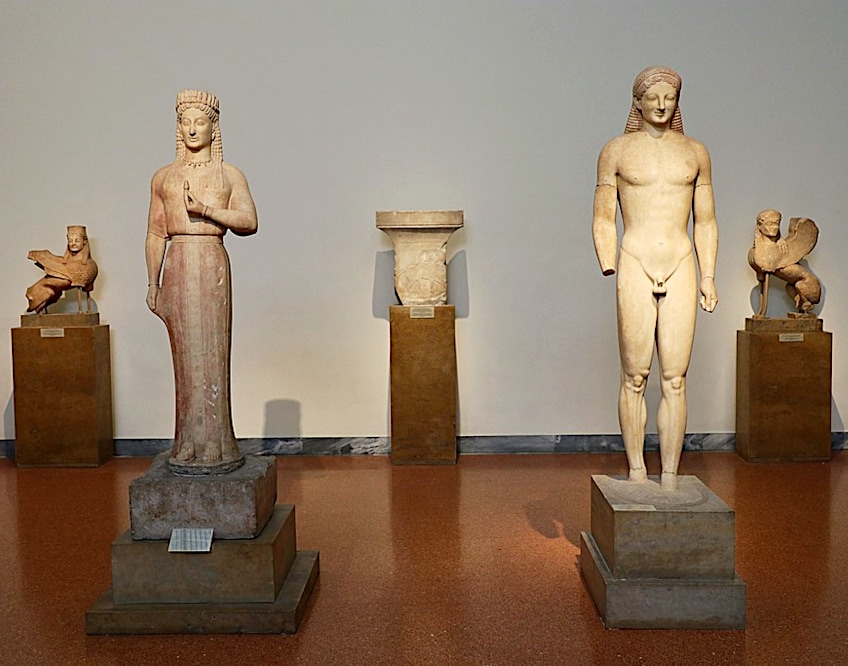 Kore and a kouros, two sphinxes and a grave stele. (6th Century BCE); George E. Koronaios, CC BY-SA 4.0, via Wikimedia Commons
Kore and a kouros, two sphinxes and a grave stele. (6th Century BCE); George E. Koronaios, CC BY-SA 4.0, via Wikimedia Commons
These kouros and kores statues would usually be produced quite large in size and be erected outside city walls or in sanctuaries to act as markers or as gifts presented to the Greek gods. Many high-society members would commission costly monuments for funerary purposes if a family member passed away at a young age. Kouros and kores would also appear as stelae decorations in relief sculptures.
Archaic Greek Vase Painting
Vase painting was one of the most famous art forms from Archaic Greece that featured many mythological scenes. Greek culture was heavily connected with mythology and was thus one of the dominant aspects of the culture. One of the most popular vase painting styles was the black figure painting style that emerged at the beginning of the 7th century. Potters often made incisions in the clay to highlight details and create interesting outlines of figures.
It is believed that the craft of incision-making was an influence derived from Eastern metalworkers, which inspired potters in Greece to show off their eye for detail and décor.
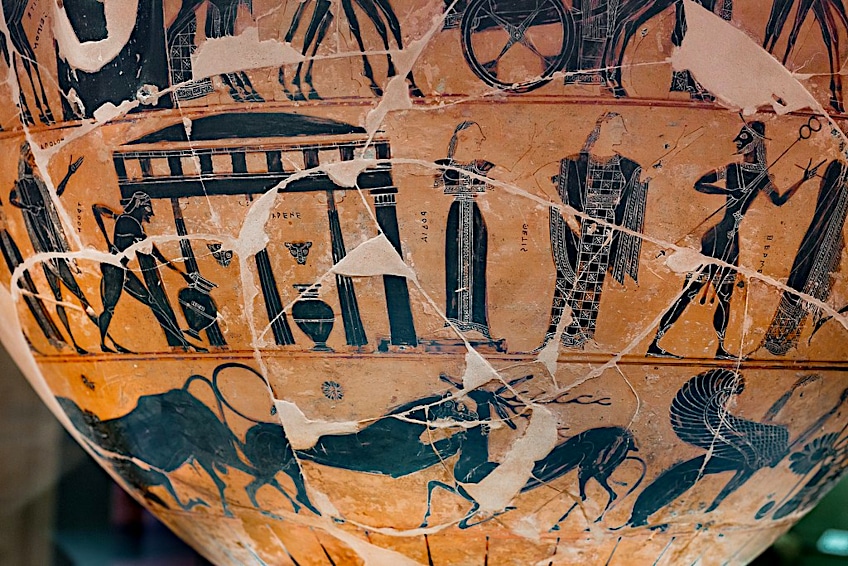 Detail from the Francois Vase by Kleitias (570 – 565 BCE); ArchaiOptix, CC BY-SA 4.0, via Wikimedia Commons
Detail from the Francois Vase by Kleitias (570 – 565 BCE); ArchaiOptix, CC BY-SA 4.0, via Wikimedia Commons
Toward the end of the Archaic period, red-figure pottery in Athens stole the spotlight and was first produced around 525 BCE by an artist known as the Andokides painter. The Andokides painter was a vase painting specialist who operated between 530 and 515 BCE and whose paintings were often unsigned so his true identity remains a mystery.
Stylistic elements in his work helped specialists identify his unique artistic approach to painting and were traced back to several vases that illustrate his style. The Andokides painter is one of the earliest known artists of the Archaic Greek period to work in the red-figure style. A total of 14 amphorae with two cups have been classified as his work with six works displaying a combination of black-figure and red-figure styles. Other famous Attic painters included the Amasis painter, Sophilos, Nearchos, Exekias, Lydos, and Kleitias.
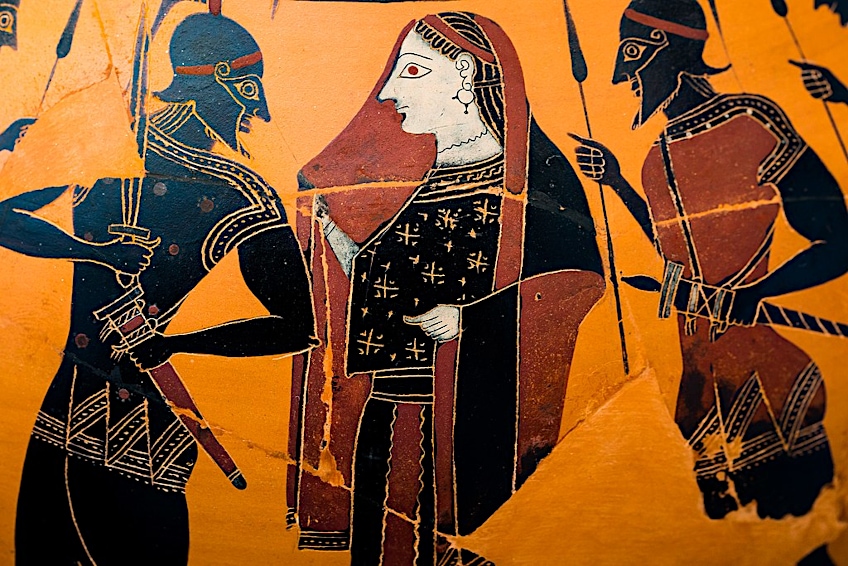 Vase by the Amasis painter depicting Menelaos recovering Helena on one side and Dionysos with youths on the other (550 – 540 BCE); ArchaiOptix, CC BY-SA 4.0, via Wikimedia Commons
Vase by the Amasis painter depicting Menelaos recovering Helena on one side and Dionysos with youths on the other (550 – 540 BCE); ArchaiOptix, CC BY-SA 4.0, via Wikimedia Commons
Other Famous Vase Painting Techniques
Other painting techniques such as the six’s technique and the white ground technique also originated alongside red-figure painting. The white-ground method involved the painting of figures on a white background and was invented in Attica around 500 BCE. These types of painted vases were commonly reserved for funerary and ritual functions and were distinguished by their fragile surfaces.
The six’s method is a Contemporary term that refers to the style of vase painting employed by black-figure painters from Attica and involved the layering of white or red figures on a black background and creating incisions to highlight the details and emphasize the dark background.
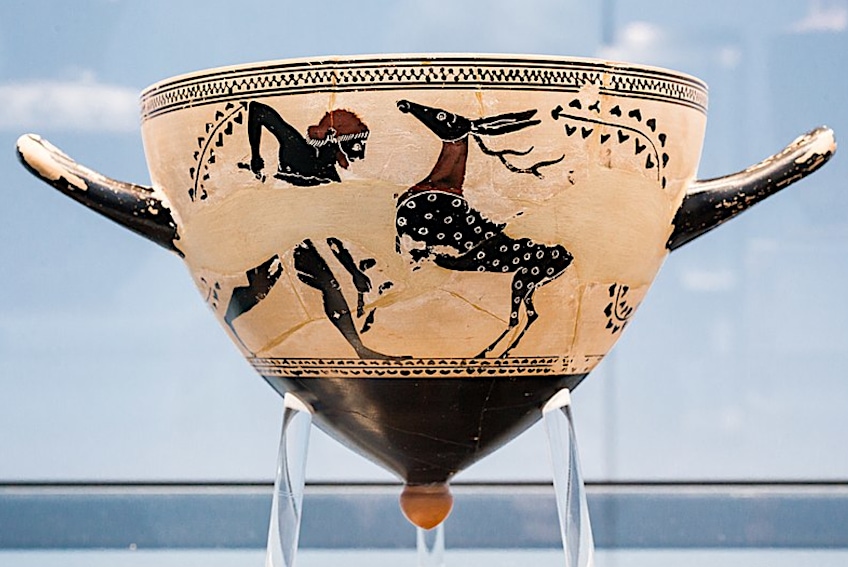 Attic black figure white ground mastos painted in the style of Psiax (510 BCE); ArchaiOptix, CC BY-SA 4.0, via Wikimedia Commons
Attic black figure white ground mastos painted in the style of Psiax (510 BCE); ArchaiOptix, CC BY-SA 4.0, via Wikimedia Commons
The name of the technique was coined in English by British archaeologist and art historian, J. D. Beazley, who found reference to the term from the Dutch scholar Jan Six. By 530 BCE, the six techniques were used to decorate the entire surface of vases and were adopted by artists such as Diosphos, Nikosthenes, and Psiax.
Examples of Archaic Greek Artworks
Now that we have covered the major Archaic Greek period art forms and styles, we can now examine some interesting examples of Archaic Greek artworks that include Archaic sculpture and Archaic Greek pottery.
Kouros Marble Statue (590 – 580 BCE) by Attic Artist
| Artist | Unknown artist of Attic origin |
| Date | 590 – 580 BCE |
| Medium | Marble; Naxian |
| Culture | Attic; Greek |
| Dimensions (cm) | 194.6 × 51.6 × 63.2 |
| Where It Is Housed | The Metropolitan Museum of Art, New York, United States |
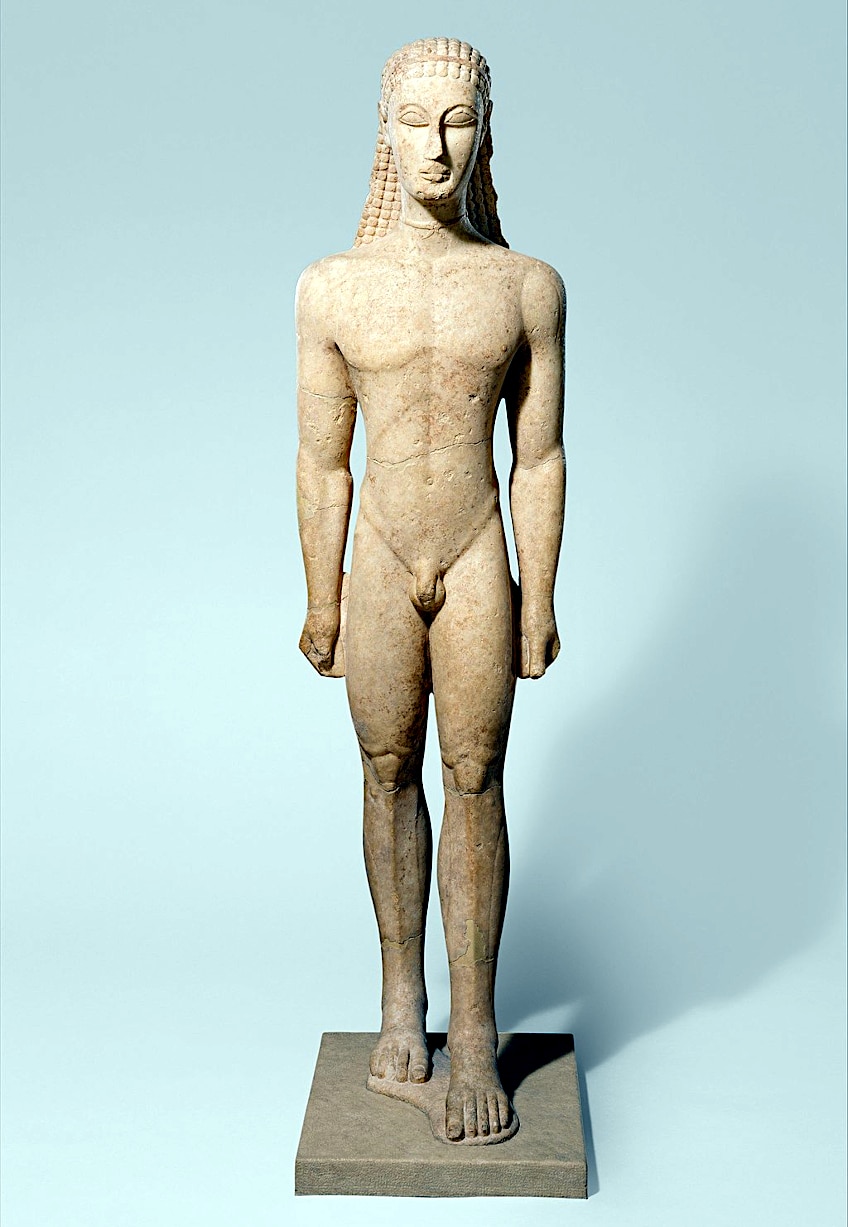 Attic marble statue of a Kouros also known as the New York Kouros (590 – 180 BCE); Metropolitan Museum of Art, CC0, via Wikimedia Commons
Attic marble statue of a Kouros also known as the New York Kouros (590 – 180 BCE); Metropolitan Museum of Art, CC0, via Wikimedia Commons
This marble kouros statue was created in Attica and was discovered at the grave of an Athenian aristocrat who died at a young age. The pose used by the unknown artist was a popular element in kouros sculptures of the 6th century. The figure of the young man is believed to originate from the early Archaic period as seen in the presence of dominant geometric forms and analogous pattern work on the anatomy.
The pose of the figure was inspired by Egyptian art as seen in the rigid stance with the figure’s arms at his sides and one foot forward.
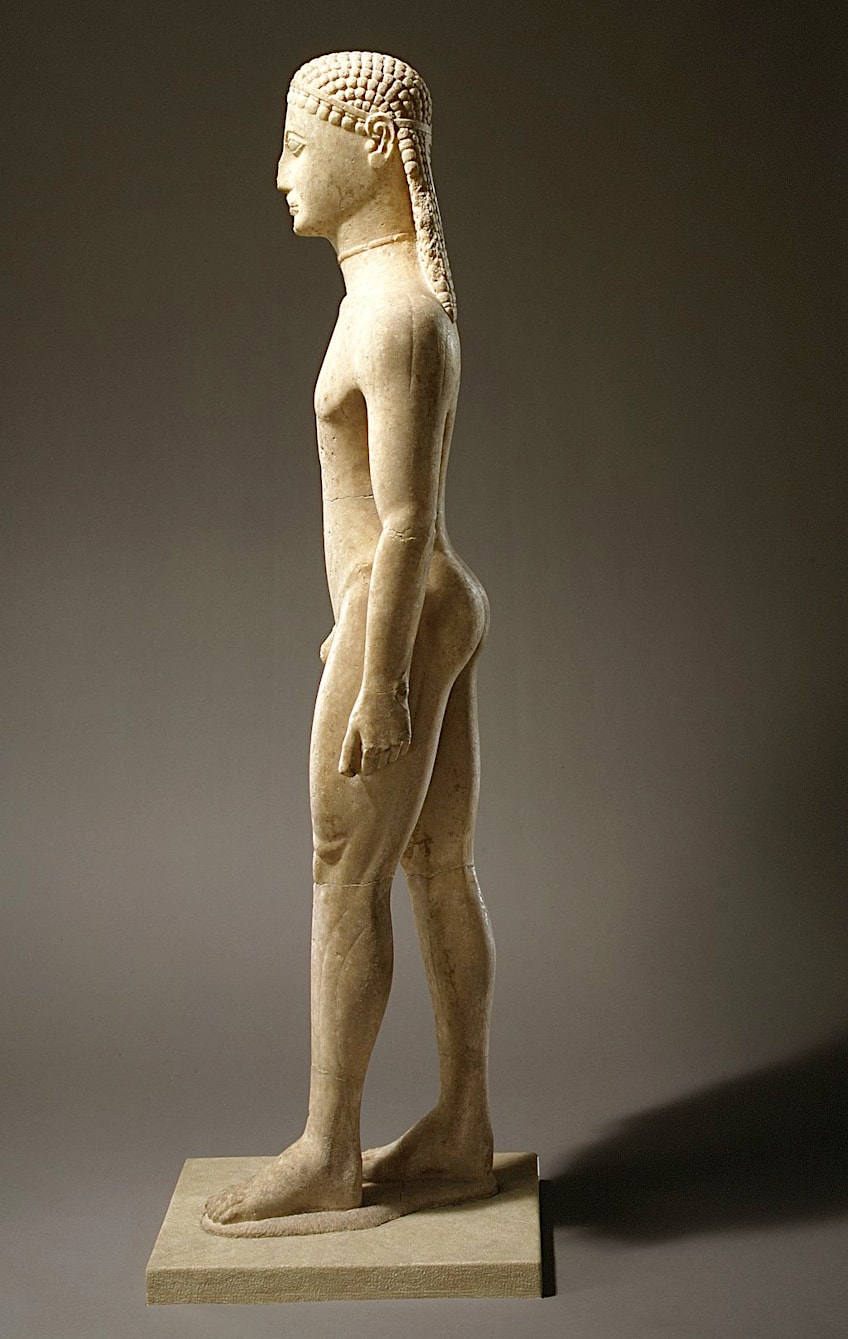 Side view of an Attic marble statue of a Kouros also known as the New York Kouros (590 – 180 BCE); Metropolitan Museum of Art, CC0, via Wikimedia Commons
Side view of an Attic marble statue of a Kouros also known as the New York Kouros (590 – 180 BCE); Metropolitan Museum of Art, CC0, via Wikimedia Commons
Terracotta Column-Krater (c. 550 BCE) by Lydos
| Artist | Lydos (Active between 560 – 540 BCE) |
| Date | 550 BCE |
| Medium | Terracotta |
| Style | Black-figure |
| Culture | Attic; Greek |
| Dimensions (cm) | 56.4 x 69.3 x 58.6 |
| Where It Is Housed | The Metropolitan Museum of Art, New York, United States |
This Terracotta Column-Krater is a black-figure painted bowl that was commonly used to mix wine and water and is believed to be created by an artist known as Lydos. Lydos operated between 560 and 540 BCE and is believed to have migrated from the Lydian empire to Athens. Lydos was a well-known Athenian black-figure vase painter who painted mythological scenes. Mixing bowls such as this bowl were used in all-male Athenian drinking parties called symposiums, which formed an important part of Greek culture. The Greeks considered people who drank wine neat and unmixed with water complete barbarians.
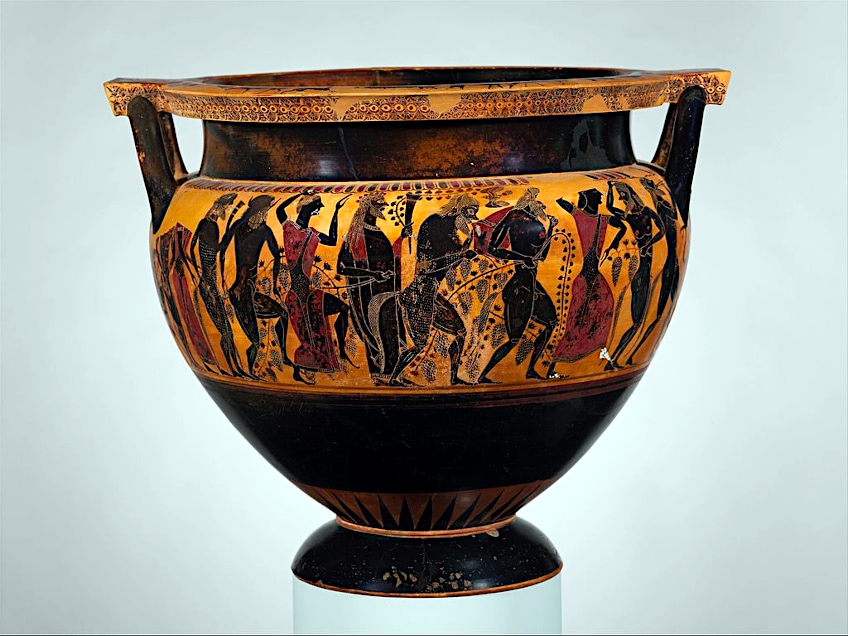 Attic Terracotta column-krater attributed to Lydos (c 550 BCE). As is appropriate for a wine-mixing vessel, the decoration shows the god of wine Dionysus and his attendants; Lydos, CC0, via Wikimedia Commons
Attic Terracotta column-krater attributed to Lydos (c 550 BCE). As is appropriate for a wine-mixing vessel, the decoration shows the god of wine Dionysus and his attendants; Lydos, CC0, via Wikimedia Commons
Painted vessels occupied a variety of uses in everyday Greek culture and were mostly used for storing food, water, and wine or for the transportation of goods to other regions. Amphorae were used to store and transport goods while hydriai were used to draw water, and kantharoi/kylikes were used to consume drinks. Other vessels called lekythos and loutrophoroi were used in ritual practices involving bridal baths and pouring libations.
The Terracotta Column-Krater is housed at the New York Metropolitan Museum of Art and features the mythological figures of Hephaistos and Dionysus among maenads. The cultural significance of the drinking parties was instituted so that people could network with each other and engage in business. Wine vases were common objects present at such gatherings where the wine would be diluted and then served. Many black-figure painted vessels featured detailed mythological designs and also included images of symposium activities. Artists of the Archaic period were important to the documentation of Greek culture, which provides us with insight into the lifestyle of Athenian civilization.
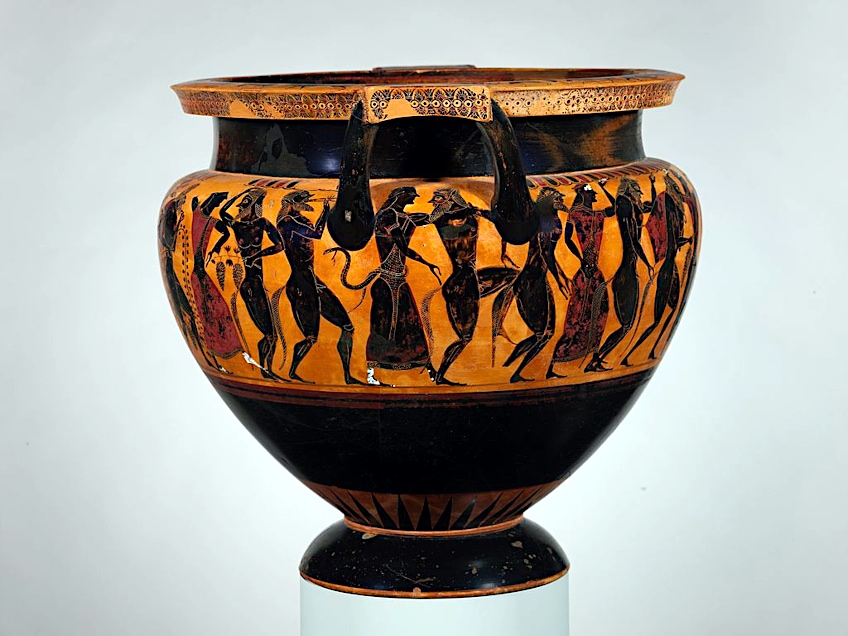 Side view of the Attic Terracotta column-krater attributed to Lydos (c 550 BCE) showing the procession of maenads and satyrs; Lydos, CC0, via Wikimedia Commons
Side view of the Attic Terracotta column-krater attributed to Lydos (c 550 BCE) showing the procession of maenads and satyrs; Lydos, CC0, via Wikimedia Commons
Terracotta Head of a Woman (1st Quarter of 5th Century BCE)
| Artist | Unknown |
| Date | The first quarter of the 5th century BCE |
| Medium | Terracotta |
| Culture | Greek |
| Dimensions (cm) | 20.7 |
| Where It Is Housed | The Metropolitan Museum of Art, New York, United States |
This terracotta sculpted head of a woman or sphinx is one of the rarest Archaic Greek sculptures in history, recognized for its large scale and was most likely part of the décor of the acroterion of a small building. An acroterion refers to the embellishments added to the apex and corners of the roof structure. The head also contains traces of polychrome paint on the headband and the earrings.
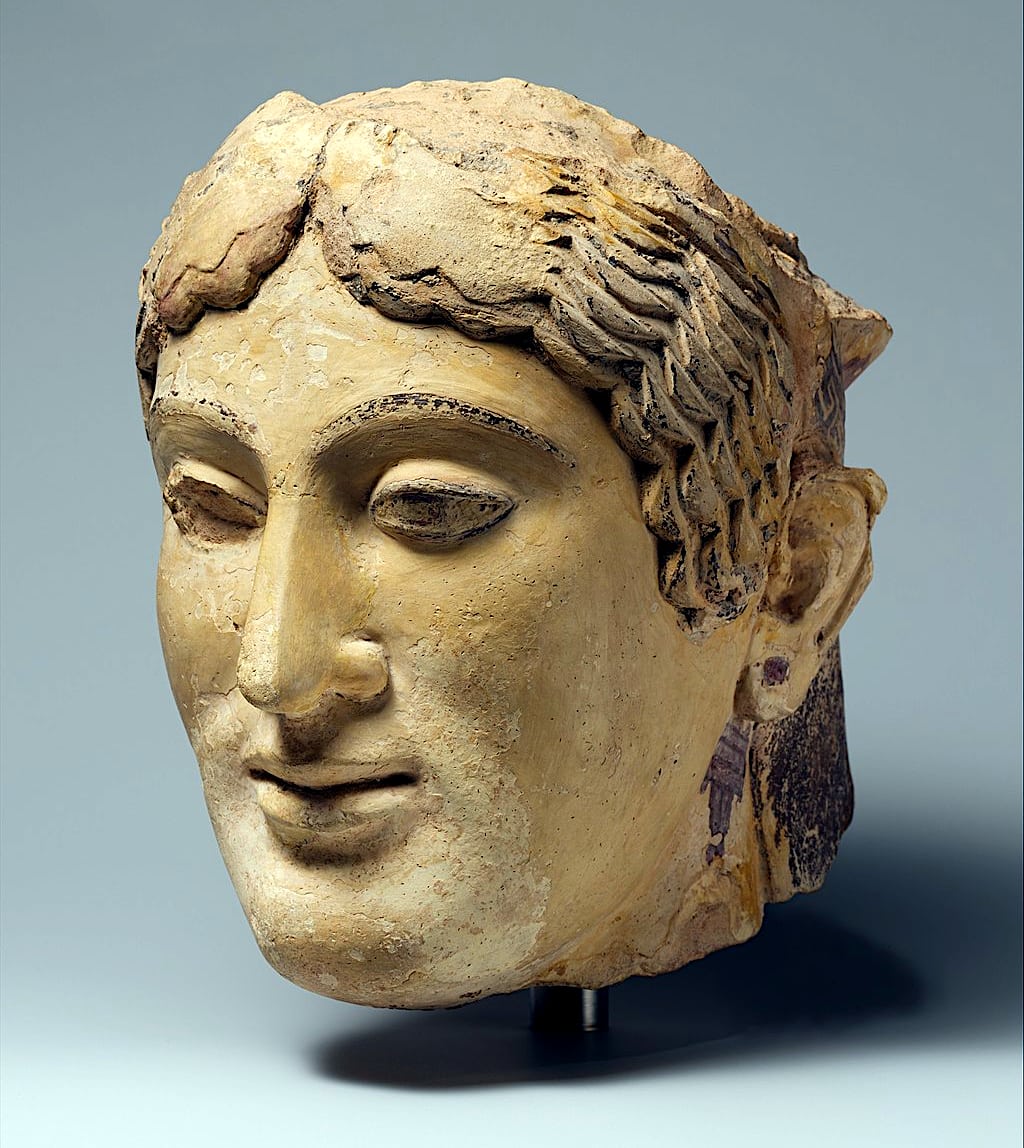 Terracotta head of a woman, probably a sphinx (early 5th Century BCE); Metropolitan Museum of Art, CC0, via Wikimedia Commons
Terracotta head of a woman, probably a sphinx (early 5th Century BCE); Metropolitan Museum of Art, CC0, via Wikimedia Commons
Significant Developments in Archaic-Period Greece
The significance of art made in Archaic period Greece lies in the growth in sculptural productions, which not only saw the invention of new techniques and painting styles but also provided insight into the development of culture concerning the idealization of human figures and one of the first civilizations to focus on the perfect representation of human anatomy.
The representation of the human form in Archaic sculpture is a recurring theme in art history that has always been realized in different ways. Sculpture and painting, as seen on pottery and painted vases, show us the way that early Greek cultures stylized and leveraged mythology and “concepts” of what humans should look like and strive to achieve.
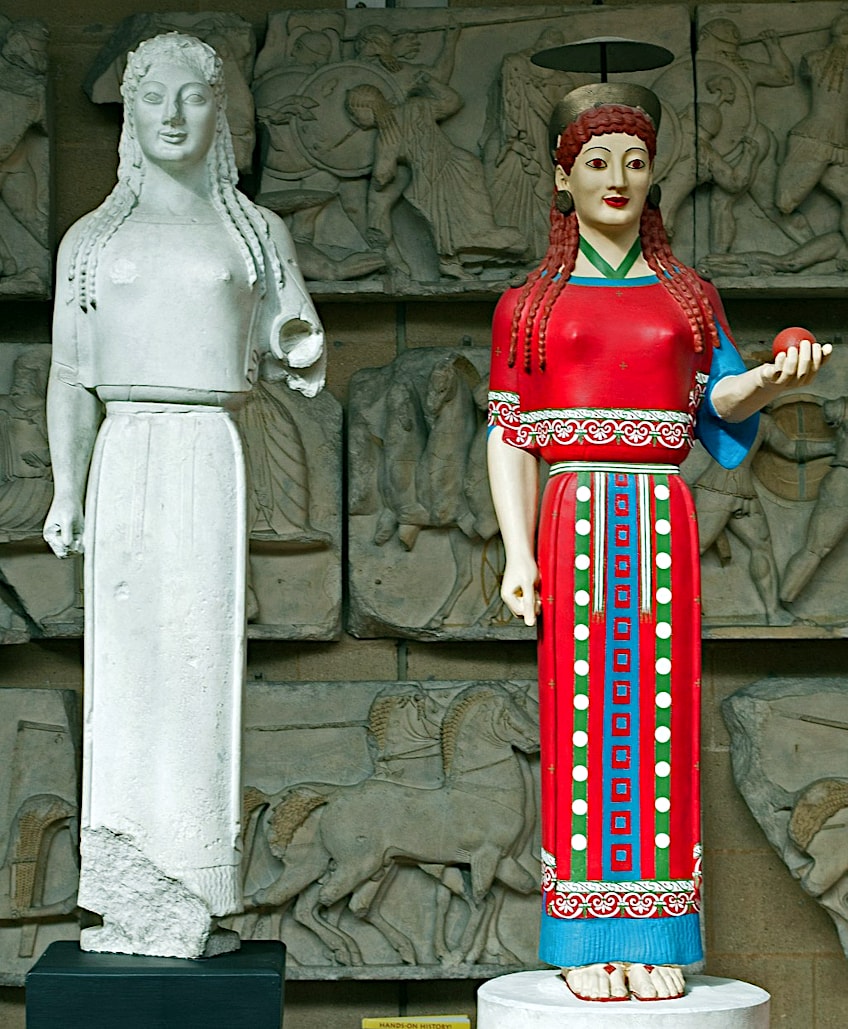 Plaster cast and reconstruction of the Peplos Kore from the Parthenon (c. 530 BCE); Zde, CC BY-SA 4.0, via Wikimedia Commons
Plaster cast and reconstruction of the Peplos Kore from the Parthenon (c. 530 BCE); Zde, CC BY-SA 4.0, via Wikimedia Commons
The kouros and kore status are an example of how ideal bodies are presented in a sculptural form to the Gods in funerary customs as well as serving as essentialized symbols of beauty. The transition away from geometric forms of representation was also significant since it humanized the image of the human in some way while maintaining a convention of idealized beauty. This was also significant for the beginning of the Classical period, which led to other key cultural developments such as democracy, the Persian wars, and some of the best-known figures in philosophy.
The Archaic period in Greek art is important to grasp the broader context of how early Greek art and culture informed the most major turning points in Greek history. Understanding early visual aesthetics, preferences, and influences helps one not only pinpoint a trajectory of development but fully comprehend the significance of such periods of transition in art history.
Frequently Asked Questions
What Was the Archaic Period in Greece?
The Archaic period in Greece was a period of significant change in the population and cultural development that occurred between 800 BCE and 480 BCE.
What Is Archaic Greek Art?
Archaic Greek art refers to the period in ancient Greek art history that is characterized by the transition from the Geometric period to the Classical period, between the 9th and the 5th centuries. Art from this period encompasses art forms such as Archaic Greek sculpture, vase painting, architecture, and pottery.
What Are the Two Major Types of Art of the Greek Archaic Period?
The two major types of art that dominated the Archaic period include sculpture involving the kouros and kore statues, which represent idealized human figures as well as pottery as seen through the development of pottery techniques and vase painting for décor.

I am deeply passionate about history and am constantly fascinated by the rich and complex stories of the past. As the editor-in-chief of learning-history.com, I have the opportunity to share this passion with a wide audience through the creation and distribution of engaging and informative content about historical events, persons, and cultures. Whether it’s through writing articles and blog posts or creating videos or podcasts, I strive to bring the past to life in a way that is both accurate and enjoyable. My expertise in history, combined with my strong writing and communication skills, allows me to effectively communicate complex historical concepts and make them accessible and interesting to a wide range of readers. I am truly grateful for the opportunity to share my love of history with others through my work on learning-history.com.

